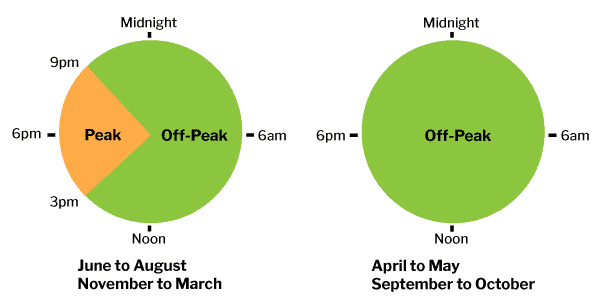Nearly half of households in the Ausgrid network are on the Seasonal Time of Use tariff, also called EA025. From July 1, there’s a big change coming.
The network’s Time of Use tariff currently has three periods: Peak, Shoulder, and Off-peak. Things will get simpler with the EA025 tariff moving to two periods: Peak and Off-peak. We’ll break down the changes.
One peak period for eight months
From July 1, the peak window will be between 3pm to 9pm – 7 days a week. This peak period will apply for eight months, including Summer (November to March) and Winter (June to August).
Some Time of Use customers on EA025 may not know this is a seasonal tariff. That’s because some retailers charge a peak rate throughout the year.
The existing shoulder period will be merged with the off-peak period, which means there will be a longer off-peak period extending for 18 hours every day.
Four months of Off-peak only
All network usage charges will be off-peak for four months of the year. From September to October and between April and May – there is no peak charge on the network tariff.

Less to think about
The move to simplify the tariff is a good one. Households can focus on being savvy around shifting energy use away from Peak hours.
After that, any other time is an off-peak rate. Plus, there will be four months of the year with no peak rate!
What will happen to my bills?
22 retailers are offering the Time of Use tariff to households in the Ausgrid network. Several retailers don’t follow the EA025 TOU periods. Some make up their own hours. Others still charge peak rates in the four months the network doesn’t. Ultimately, retailers are free to adjust the structure of the tariff. So, it’s wishful thinking to believe that from July 1, every retailer will start to follow the new two-rate tariff. But it seems likely that most retailers will. In Victoria, all networks have a two-rate time of use tariff with identical peak hours from 3 pm to 9pm. Retailers are very consistent in applying the network hours. So if Victoria are anything to go by, we may see every retailer precisely following the tariff periods.
Some Retailers may take a little time to get their billing systems and backend sorted. At the same time, others are already ahead of the game. GloBird has always charged a two-rate Time of Use in Ausgrid, with identical rates for shoulder and off-peak periods.
There’s also a range of other tariff updates happening from July 1, 2024 in the Ausgrid network.
Controlled load switching
Ausgrid’s controlled load device switching times are changing. This is designed to coincide with daytime solar energy production, soaking up more of the solar export, creating headaches for the network. Given the abundance of daytime residential solar, this is more than overdue. In 2024, running appliances like hot water units overnight doesn’t make sense at the time when wholesale costs are higher. The network has a ‘problem’ with surges in daytime solar, so running controlled load to soak up solar, is a great solution
Controlled load 1 (EA030) Supply is usually available for at least 6 hours in any 24-hour period, from midnight to midnight.
Controlled load 2 (EA040) Supply is usually available for at least 16 hours within any 24-hour period, from midnight to midnight, with more than 4 hours between 7am-5 pm.
Clearing out legacy tariffs
The Ausgrid network will also be removing some legacy tariffs:
From July 1 2024 customers on the Residential transitional TOU (EA011) – which was a flat rate – will be moved to the EA025. The transitional TOU tariff was only supposed to be available to customers for twelve months before moving to a Time of Use, so it was arguably a half-step.
Customers on the residential TOU demand (EA115) will also be moved to the TOU tariff (EA025) depending on their meter type.

